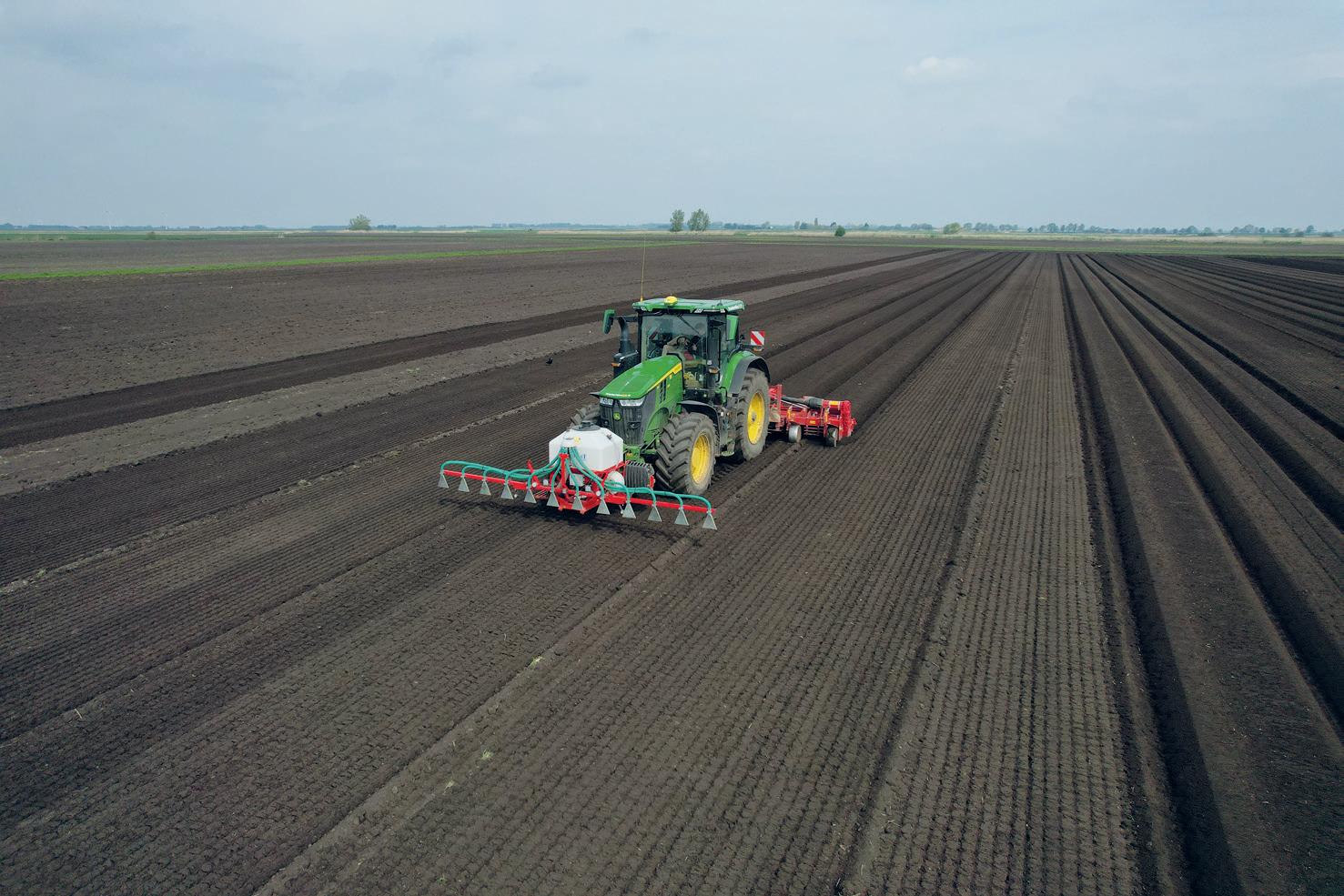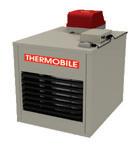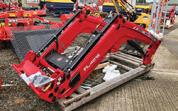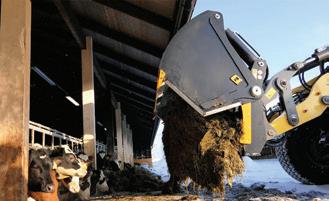Essential Farm

covering East Anglia and the Midlands







covering East Anglia and the Midlands





Editor:
Johann Tasker | T: 07967 634971
E: johann@ruralcity.co.uk
Advertising sales:
Danny Lewis | T: 01502 725862
E: danny.lewis@micropress.co.uk
Advertisement production:
Jade Soanes | T: 01502 725840
E: jade.soanes@micropress.co.uk
Essential Farm Machinery is published monthly for farmers and growers in the eastern counties and the Midlands. It is mailed with Anglia Farmer and Midland Farmer magazines and is also available at selected farm machinery and supplies outlets.
© Countrywide Publications 2024
Published by Countrywide
Publications, Fountain Way, Reydon, Suffolk IP18 6DH
T: 01502 725800
Printed by Micropress Ltd, Suffolk
T: 01502 725800

TQuadtrac 715 has won one of the design industry’s most respected global prizes in recognition of its styling and performance.
First presented in 1954, the iF Design Awards are seen as one of the most respected design competitions, recognising the importance of product design across multiple varied consumer and commercial product categories.
Some 10,800 entries from 72 countries were entered for the 2024 awards. The Case IH Quadtrac 715 was a winner in the Industrial Machine category after a two-part selection process overseen by globally-respected design experts from across the sector.

SUITABLE FOR THE FOLLOWING APPLICATIONS:
Agricultural applications: Separation of cow, pig and chicken manure
Food industry: Separation of vegetable waste
• Slaughter houses: Separation of paunch content
Adrian Tindall 07708 919597
and aesthetics with enhanced functionality are granted the iF seal – recognising their customer benefits while acknowledging the important role of good design.
The styling of the new Quadtrac 715 sets it apart from established models in the Quadtrac range, underlining the tractor’s greater pulling power and its ability to achieve greater soil protection via its larger footprint.
The styling has practical benefits too: the hood incorporates new air intake grills to cool the larger, higher-output FPT Cursor 16L TST 15.9-litre engine and features a new lighting design, with new LED road lights .
•
Rob Jackson 07939 410417 r.jackson@bauer-at.com


Just a few weeks remain for farmers and contractors to apply for grants from the latest round of Defra’s Farming Equipment and Technology Fund (FETF).
The fund provides grants for farm equipment and technology that contribute to improvements in productivity, slurry management and animal health and welfare.
Successful applicants will receive grants of up to £50,000 towards the cost of eligible items from an approved list of equipment. Closing dates are 17 April for productivity and slurry items; and 1 May for animal health and welfare items.
The fund aims to help farm businesses invest in the tools they need to improve sustainable food production across agriculture, horticulture and
Some generous grants are being offered
forestry. Thousands of applications were made to the fund last year.
Defra says it has allocated some £70m to the Farming Equipment and Technology Fund to support farmers with the costs of eligible items to build the resilience of the sector and boost UK food security.

Right: Fixed and mobile slurry separators are eligible for grants
Below: A range of slurry equipment is eligible for funding
Some £116m has been allocated for grants for infrastructure and equipment to support slurry management; with £91m earmarked for grants for equipment, technology and infrastructure designed to improve the health and welfare of livestock.
The fund is competitive. The Rural Payments Agency will allocate funding after all applications have been received. Applicants may not receive any, or all, funding applied for.

the procurement of equipment and technology that require fewer inputs, reduce emissions and cut waste.
Terry Baker, managing director of slurry management specialists
Tramspread, suggested farmers should consider making use of the grants to reduce capital expenditure and use slurry more efficiently..
This could include equipment that could help farmers reduce the amount of slurry storage needed.
“The government wants all slurry covered by 2027 to lower agricultural emissions and there are some generous grants being offered now.”
Megan Proctor, a rural surveyor with Galbraith, said: “This is a useful source of support for farm businesses, particularly as input costs have risen significantly, especially for feed and fertiliser.
“It is worth setting aside some time to assess what equipment you may need and whether it is covered by the scheme. It can feel like just more paperwork at a very busy time of the year, but in our experience it is well worth submitting an application.”
For details, visit bit.ly/FETF2024




Richard Hellyer Farm Manager
on a 700ha heavy clay farm at Hatley St George, Bedfordshire

labour and fuel costs. The Triton has allowed us to drop spring drilled from rotation. The Triton with dramatic reduction in and with wheats averaging 11tha which higher getting from heavy cultivation and It true to that the will drill clay in virtually any and gives the confidence wheat later black
We purchased the Triton 6m drill in 2021 to replace heavy cultivations and reduce labour and fuel costs. The Triton has allowed us to maximise our winter wheat acreage and drop spring drilled crops from the rotation. The Triton drill has exceeded our expectations with a dramatic reduction in costs and with wheats averaging 11tha which is higher than we were getting from our previous heavy cultivation and plough system. It is true to say that the Triton will drill clay effectively in virtually any conditions and gives the confidence to drill wheat later to reduce black grass.
labour and fuel costs. The Triton has allowed us to drop spring drilled crops from the rotation. The Triton drill has exceeded our expectations with a dramatic reduction in costs and with wheats averaging 11tha which is higher than we were getting from our previous heavy cultivation and plough system. It is true to say that the Triton will drill clay effectively in virtually any conditions and gives the confidence to drill wheat later to reduce black grass.
Twin hold roll pin blade removal system and backward leaning air borne upper blade for trash lift and ease of trash flow
backward leaning air borne upper blade for trash lift and ease of trash flow
Twin hold roll pin blade removal system and backward leaning air borne upper blade for trash lift and ease of trash flow
Seed depth tail 40mm deep holding the seed at correct depth and placing seed on either side of seed terrace
Seed depth tail 40mm deep holding the seed at correct depth and placing seed on either side of seed terrace
at correct depth and placing seed on either side of seed terrace
direct drill in 2018 to give plough based yields from direct drilling. Six years later we are
Triton than from ploughed trials on our own land. The Triton is the only all weather seed drill on the market that gives the flexibility whilst reducing blackgrass from late drilling. A number of other manufacturers are now claiming all weather capabilities – don't
Triton launched its unique deep soil engagement direct drill in 2018 to give plough based yields from direct drilling. Six years later we are consistently achieving higher yields from the Triton than from ploughed trials on our own land. The Triton is the only all weather seed drill on the market that gives the flexibility to grow maximum profit autumn sown crops whilst reducing blackgrass from late drilling. A number of other manufacturers are now claiming all weather capabilities – don't be caught out, get a demo against a Triton.
Triton launched its unique deep soil engagement direct drill in 2018 to give plough based yields from direct drilling. Six years later we are consistently achieving higher yields from the Triton than from ploughed trials on our own land. The Triton is the only all weather seed drill on the market that gives the flexibility to grow maximum profit autumn sown crops whilst reducing blackgrass from late drilling. A number of other manufacturers are now claiming all weather capabilities – don't be caught out, get a demo against a Triton.
daily videos @tritonuk
facing upper blade does from below stale seed bed
Downward facing upper blade does not hook grass weed seed up from below stale seed bed and field surface
Downward facing upper blade does not hook grass weed seed up from below stale seed bed and field surface
Triangular tungsten tiles for reduced draught and soil disturbance
Triangular tungsten tiles for reduced draught and soil disturbance
reduced draught and soil disturbance

Drilling at 40mm depth
Drilling at 40mm depth
facing upper blade holds field surface
minimising soil eruption in the stale seed bed
Downward facing upper blade holds field surface in place minimising soil eruption in the stale seed bed
Downward facing upper blade holds field surface in place minimising soil eruption in the stale seed bed
14cm deep lower blade takes blade deep below ground for air drainage and rooting
14cm deep lower blade takes blade deep below ground for air drainage and rooting
14cm deep lower blade takes blade deep below ground for air drainage and rooting
Triton UK: 01223 891888 (East Anglia & Midlands)
Triton North & Scotland: 07712 831718 (Steve) (S.T. Gowan Agri)
Southern agent: 07970 549012 (Richard Peck)
Triton UK: 01223 891888 (East Anglia & Midlands)
Triton North & Scotland: 07712 831718 (Steve) (S.T. Gowan Agri)
Abington Farm Park, Great Abington, Cambridgeshire CB21 6AX
Abington Farm Park, Great Abington, Cambridgeshire CB21 6AX
www.tritonseeddrills.com
www.tritonseeddrills.com

Anew generation of front loaders with better performance and improved comfort features has been launched by Claas.
loading machines. They feature a new, innovative three-section design with a double-angled boom.
Better view from cab
This shifts the pivot point mechanism of downwards by more than 20cm –giving the operator a better view of the frame and attachment, especially as the front crossbeam has been lowered by 10 cm.
The new design features the customary robustness and manufacturing quality that is a hallmark of Claas front loaders. The boom is designed for the most demanding tasks, says the company. All hydraulic hoses are integrated into the frame for protection.
Automatic bucket return is available on request. The familiar Fitlock coupling system from the FL and FL C front loaders has been retained; and the locking mechanism is fully automatic and entirely mechanical.
To unlock, the operator simply releases a small lever on the boom. A multi-coupling system means all hydraulic and electrical lines can be connected to the tractor in an instant –without the need for any additional plug connections.
With the optional hydraulic Fastlock system, attachments can be locked at the press of a button from the comfort of the cab, in addition to automatic mechanical locking. Third and fourth functions can be connected via the multi-coupler.
The new range replaces the previous FL C series with integrated mechanical self-levelling linkage. Six new models cover lift capacities from 940-2,490kg and a breakaway force of 1,820-3,120 kg. Maximum lift height is 3.50-4.50m.
Claas saysn the boom is designed for the most demanding tasks.
Claas says the new FL C series front loaders transform the Eaxos and Arion tractors into even more productive
This year’s slow start to farm tractor registrations continued into February, says the Agricultural Engineers Association.
Some 477 new machines were registered during the month – some 10 fewer than the same month last year. But the figure was 16% below the average for the time of year in the previous five years.
AEA economist Stephen Howarth said: “That was a similar shortfall, compared with the seasonal norm, to that seen in January, although the year-on-year decline was much smaller than during that month.
“The total for the opening two months of the year was the lowest since 2001 but these are traditionally quiet months. We will know more about the state of the market when figures are available March, typically the peak month each year.”
A pressure relief function for the third function is available on request. The automatic bucket return function automatically returns the bucket to the horizontal loading position – increasing operator comfort and productivity to boot.
Kuhn Farm Machinery is celebrating 10 years since the launch of its Twinpact double plunger design for its high-density large square balers.
The double plunger has transformed the operation of its SB 1290 iD balers, allowing operators to produce high density, uniformed bales without increasing the load or strain on machine and operator.
The result is 25% higher bale densities in dry crops compared to conventional balers.
Kuhn’s Twinpact design splits the plunger into upper and lower sections connected via a triangle rod. The
sections compact the bale in series during a complete plunger cycle, with greater force applied while avoiding peak loads on the machine.
Kuhn grassland product specialist Rhodri Jenkins says the design is still a key attraction for users.
The split double plunger means they can produce higher density bales without increasing the stress on the machine, he explains.
“The low power requirement from the TwinPact design, and the reduced ‘nodding’ impact that is synonymous with weighty plungers on big square balers, are features that users require on modern machines.”
• Further investment in the pipeline
• Accuracy key to farm profitability
Accurate nematicide application is more critical than ever, says a Cambridgeshire potato grower keen to keep costs as low as possible.
Ollie Dennis, of Dennis (Haddenham) Limited, runs a 700ha arable farm that includes 400ha of potatoes grown for the crisping, chipping, packing and processing markets.
Mr Dennis manages the family business alongside his father Jonathan and uncle William. Tight margins mean it is important to pay attention to detail and employ the best technology and
equipment to optimise costs.
“In the 80 years since my great grandfather first established the busi ness, I’d certainly argue that the last 10 years have seen as much change as the previous 70,” says Mr Dennis.
“However, as farmers, we often have to remind ourselves that external factors such as unpredictable weather, Brexit, inflation and larger geopoliti cal events such as the war in Ukraine are out of our control.
“It’s all about focusing on the ele ments we can control, and that obvi ously includes keeping on-farm pro


Hugh Pearl Lane Drainage


is simple to use, quick to set up, and uses the same Garmin GPS electronic rate controller as other Techneat machines - cab mounted and designed for
“Applying the nematicide is safe, accurate and straightforward with a closed transfer filling system. The machine has 12 fishtail outlets at 450mm intervals along the width of a 5.4m boom, delivering the product precisely within our three-bed system
“To further improve accuracy this season, we are investing in an ISOBUS controller for better variable rate control and adding auto shut-off system
With a large 400l hopper that ensures fewer stops to refill, and an allweather cover to protect the machine, the Maxicast has low running costs and high accuracy. It can also be used to
“Technical back-up and service support from Techneat has always been excellent with each Maxicast serviced pre-season alongside its annual National Sprayer Testing Scheme com-

Makita has added two new pruning products to its outdoor range.
Powered by Makita’s 18V LXT battery system, the new DUP180 Brushless Pruning Shear (pictured) and the DUC150 150mm Pruning Saw offer a com fortable and powerful solu tion to make quick and light work of repetitive or heavy prun ing jobs.
With an adjustable shear blade opening angle, the new DUP180 18V LXT Brushless Pruning Shear accom modates four different cutting capacities up to 30mm and provides up to 8,800 cuts on a single charge when used with a 6.0Ah battery.

Joining the outdoor line up is the DUC150 18V 150mm pruning saw. With an 8m/second chain speed, the machine is said to be ideal for general garden applications or orchard maintenance.
Additional comfort and efficiency-enhancing features include toolless chain tensioning and automatic chain oiling, while a brushless motor ensures low maintenance requirements and a longer motor life.




• Comprehensive tillage line-up
• Spanish mouldboard ploughs
• Italian cultivation equipment
Opico has added two key brands to its range of equipment by taking on the distribution of Ovlac ploughs and Alpego Power tillage implements.
The Lincolnshire-based company says it now offers a comprehensive line-up to cater for all approaches to crop establishment – including harrows, drills, rotary cultivators and flail toppers.
Located in northern Spain, Ovlac has been building ploughs for more than 75 years. It is the country’s largest manufacturer of soil-engaging equipment, with mouldboard ploughs being the flagship product.
Ovlac is regarded as something of a specialist in shallow inversion tillage with a range of ploughs built specifically for that growing market.
Alongside a full offering of conventional and reversible ploughs from three to nine furrows – mounted
to have a 13-body plough spanning 5m in a single pass.
Although designed to be simple and lightweight, the Mini is extremely robust and has the added advantage of working on-land to avoid furrow bottom compaction.
The principle of shallow inversion tillage favours the formation of cavities where air and moisture can work together to provide a microclimate to suit the bacteria that can decompose large volumes of crop residue.
This produces a clay-humic complex that mineralises nutrients and increases the natural fertility of the soil and, therefore, its long-term productivity.
Alpego is best known for its power-harrows and drills. The Italian company has specialised in one-pass crop establishment for over 30 years. Established by Vittorio Pegoraro in 1946, it remains within the family today.
The company also makes flail toppers, multi-purpose seed and fertiliser hoppers and rotovators. Although the business concentrates on conventional machinery it is known for its innovative design.
One example is its de-mountable seed drills for tractors with a rear load deck – the hopper and metering unit carries up over the tractor’s rear wheels to maximise traction and optimise weight distribution.

This inventive approach to engineering carries through to Alpego’s rotary cultivators. Rather than employing

Above: Alpego Poker PF 500, foldable rotary tiller
Right: Ovlac XPV hydraulic reset reversible plough
Below left: Alpego TL50 260, heavyduty lateral flail mower

Below right: Ovlac model SH hydraulic reset reversible plough
one end of the rotor, the Italian company opts instead for a gear-drive to the centre of the shaft.
This ensures an even distribution of load and means the rotovator’s overall width is equivalent to its working width without an overhanging driveline off to one side.
Opico said its takeover of the distribution of Ovlac and Alpego equipment in the UK would mean improved technical and spare parts back-up as well as additional marketing support for the existing dealer network for both brands.
The company will exhibit standard and shallow Ovlac ploughs and the full line-up of Alpego equipment at this

Machinery specialist Lemken has integrated the control of a hoeing machine so only one terminal is needed.
Previously, farmers needed two terminals if they wanted to use a hoe with camera and section control: the ISOBUS terminal for width section control and a second terminal for displaying the camera image and adjusting the hoeing machine.
With its iQblue Weeder software, Lemken says it has successfully integrated the control of the machine – including camera image and width sections – into an ISOBUS system so all controls are displayed on one CCI 800 or 1200 terminal.
The company says this provides an inexpensive, convenient and clear solution for users. The ISOBUS system

sible via either the tractor’s own joystick or the CCI joystick.
The system is also ready for highspeed ISOBUS and uses a standard ISO 17215 interface via Ethernet for transmitting the video image enriched with camera information.
Users also benefit from automatic over-the-air machine updates so their


service technicians can access the software remotely and optimise settings. Settings are then immediately displayed in the camera image for review and can be readjusted autonomously if necessary. The general menu structure of the system is in line with the Lemken standard and facilitates intuitive operation.
the Lemken system
















CASE CX50 DIGGER
Tractors & Telehandlers • MF 240 - p/steering • MF 6480 - Dyna 4, v tidy • MF 3060 - 4 autotronic, v tidy • MF 6120 - v tidy, Dyna shift, 4,700hrs • New Holland TD80 & loader, 5,900hrs • Caterpillar 407 ag telehandler (2009) - tidy • Various forks & grapples
Harvesting • MF 7278 AL combine (2006) - 24’ PF, v tidy • MF 7274 combine (2004) - 22’ table, 208hrs • MF 30 - 14’ FF - v tidy • MF 40 RS - 20’ PF - v tidy Vicon RV2160 Round Baler, v tidy • Krone 1290 HDP Baler, tidy • New Holland 980 Big Bale • Claas Liner 3100 twin rotor rake 10m • Kv Taarup 4232 3.2 trailed mower • New Holland 377 Baler
Excavators • Yanmar 8t & 3 buckets • Case CX5, 5t & 3 buckets Other Equipment • Dowdeswell DP7F, 7f, v tidy • KV LD85 5f & 4f • Flat Lift Force - 2 leg HD buster • Knight Raven, 3 leg combination, vgo • Vicon PO-EDW weightcell, vgo • Vicon RO-EDW extension hopper • Kuhn Axis 30.1 spreader extension hopper • Cousins 6.2m hyd rolls • Richard Western 12t dump trailer Armstrong & Holmes 14.5t trailer, v tidy • Bomford 9’ topper • Major 1,600g vacuum tanker • 80” mounted rotovator • 450 & 600 workshop heaters • A full range of Nugent trailers
Mark Weatherhead Ltd 01954 210 355 07885 202 005
Hardwick, Cambs CB23 7QL
www.markweatherhead.co.uk






























Farmers are testing if a selective approach to tillage can help grow maize productively while reducing costs and environmental impacts.
Maize is typically a ploughdependent crop requiring a fine seed bed. It is also easily outcompeted in its early growth stage. But heavy ploughing can lead to degraded and compacted soils that risk polluting rivers via run-off.
Working with the Farm Net Zero project in Cornwall, farmers are leading an Innovative Farmers field lab testing a strip-till approach, where the top layer of soil is disturbed in strips, rather than full immersion ploughing of the entire field.
So far, yields have been maintained – and even improved. In some cases, it has helped reduce fuel and machinery costs – and boosted soil health too.
Arable farmer Malcolm Barrett trialled two different types of striptill drill, which he compared to a control of disc cultivation – a min till technique he had already found to be a better approach for his soils.




yields from using the strip drill. The nutritional quality of the maize crop improved along with the soil structure. Fuel costs were also saved on establishment.
He said: “The difference we can see in the soil in the last two years since we started a min till approach is phenomenal. The cattle aren’t poaching the fields, we can drive our machinery across the soil without it sinking.




good results
you notice when you walk the field is the worm holes, and how the water is being absorbed into the soil instead of sitting on top.”
Mr Barrett added: “Where we have seen slight reductions in yield it’s been offset by reducing our establishment costs, and some of the losses are due to where we didn’t get our machinery to line up properly.”






























